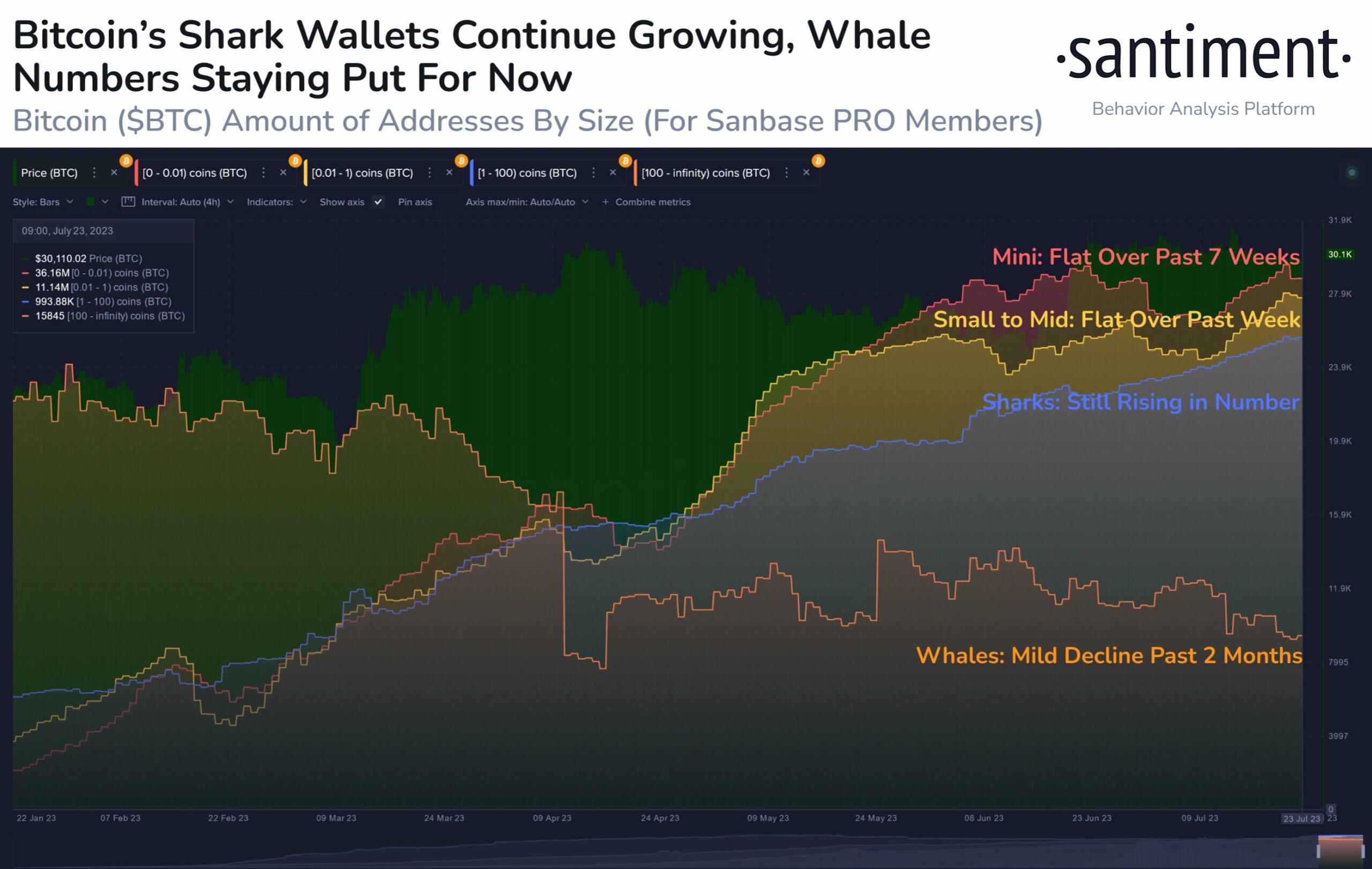Bitcoin Whales Stagnate While Shark Traders Continue to Accumulate
Contents
- The number of whales in the Bitcoin network has been experiencing a slight decrease in the past few months, according to on-chain analytics data.
- The indicator value for the 1-100 coin group, also known as “sharks” at times, has only been moving upwards in recent months.
- As reflected in the graph, the number of whales in the network has experienced a decrease in the past few months, but the degree of the downward trend has not been significant.
Bitcoin whales and retail investors are not showing much interest in accumulation, but sharks continue to accumulate BTC.
Bitcoin Sharks Continue to Accumulate
According to the data announced by on-chain analytics company Santiment, the number of whales in the Bitcoin network has been experiencing a slight decrease in the past few months. The relevant indicator, called “Supply Distribution,” measures the total number of addresses belonging to each wallet on the network.
These addresses are divided into “wallet groups” based on the amount of BTC they carry in their current balances. The four groups of interest in the current context are: 0-0.01 BTC, 0.01-1 BTC, 1-100 BTC, and 100+ BTC.
Naturally, the balance of an address belonging to any of these groups will be within the range of that group. Therefore, if Supply Distribution is applied to these groups, it tells us the total number of addresses that meet the relevant conditions on the chain (among other things).
A graph showing the trend in Bitcoin Supply Distribution for each of these four groups since the beginning of the year:
The first group, the 0-0.01 BTC range, represents small retail holders in the market. From the above graph, it can be seen that there hasn’t been much change in the number of these investors recently, as the Supply Distribution curve has been moving horizontally for the past seven weeks. This may indicate that acceptance among small investors is currently not rising for the cryptocurrency.
The second group of interest (0.01-1 BTC) has also shown a horizontal movement recently and has reached a stagnation point in the network as retail investors as a whole.
However, unlike these groups, the indicator value for the 1-100 coin group, also known as “sharks” at times, has only been moving upwards in recent months. This may suggest that owners of this size are still interested in buying cryptocurrency and this situation could be a positive sign for asset rally.
Although sharks have some influence in the market due to the size of their coin holdings, they do not have as much power as whales, who are the largest group in the market. These massive investors, who own 100+ BTC, can move a significant amount of coins in the network and therefore cause noticeable fluctuations in the market. Therefore, the behavior of these owners can be considered as one of the most important factors to be closely monitored.
As reflected in the graph, the number of whales in the network has experienced a decrease in the past few months, but the degree of the downward trend has not been significant. However, one fact remains: they have not been accumulating recently.
The future actions of these investors, as Santiment stated, could be an opportunity for a significant price increase if they start buying again.
Lucien Renard
Comments
Yorumlar
Other Articles
Bitcoin Surges to $93,888: How Venezuela-US Tensions Triggered a Crypto Rally
January 5, 2026 at 07:04 AM UTC
Tether Adds Nearly 9,000 Bitcoin to Reserves in Q4 2025, Reaching 96,185 BTC
January 1, 2026 at 03:25 PM UTC
Bitcoin’s Potential 2026 Rebound Debated Amid Bottoming Signals
January 1, 2026 at 12:16 PM UTC

